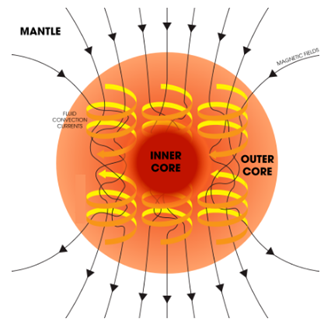Magneto-Coriolis Wave: A new type of Earth’s Waves
- 31 May 2022
Recently, scientists have detected a completely new type of magnetic wave that surges through Earth's outer core every seven years, warping the strength of our planet's magnetic field in the process.
- The waves — dubbed "Magneto-Coriolis" waves because they move along the Earth’s axis of rotation, per the Coriolis Effect — creep from East to West in tall columns.

The Study
- Scientists used data from the European Space Agency's Swarm satellites - a trio of identical probes, launched in 2013 and hanging out in Earth orbit to study the activity inside Earth – with a specific eye on the magnetic and dynamic activity coming out of the core.
- By studying this data scientists discovered the fascinating new waves.
- They then studied data from other ground- and space-based observatories, collected between 1999 and 2021, and found a pattern.
About the New Waves
- These waves, known as Magneto-Coriolis waves, are huge magnetic columns aligned along Earth's rotational axis, strongest at the equator.
- They sweep around the boundary between the core and the mantle with an amplitude of around 3 kilometers (1.86 miles) per year, and move westward at a rate of up to 1,500 kilometers (932 miles) per year.
Other Assumptions
- The existence of these waves suggest that other Magneto-Coriolis waves might exist with different oscillation periods, which we are unable to detect to date, due to a lack of data.
- Magnetic waves are likely to be triggered by disturbances deep within the Earth's fluid core, possibly related to buoyancy plumes.
Significance of this Study
- For now, because waves carry information about the medium through which they travel, new discovery could be used to probe the interior of our planet in new ways – including the core, which is difficult to study, as well as the core-mantle boundary.
- The existence of these waves could help explain mysterious fluctuations in the planet's magnetic field, which is generated by the movement of liquid iron in the planet's outer core.




